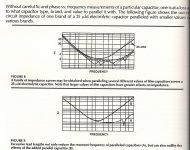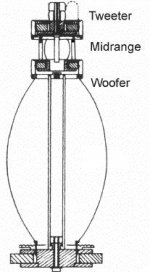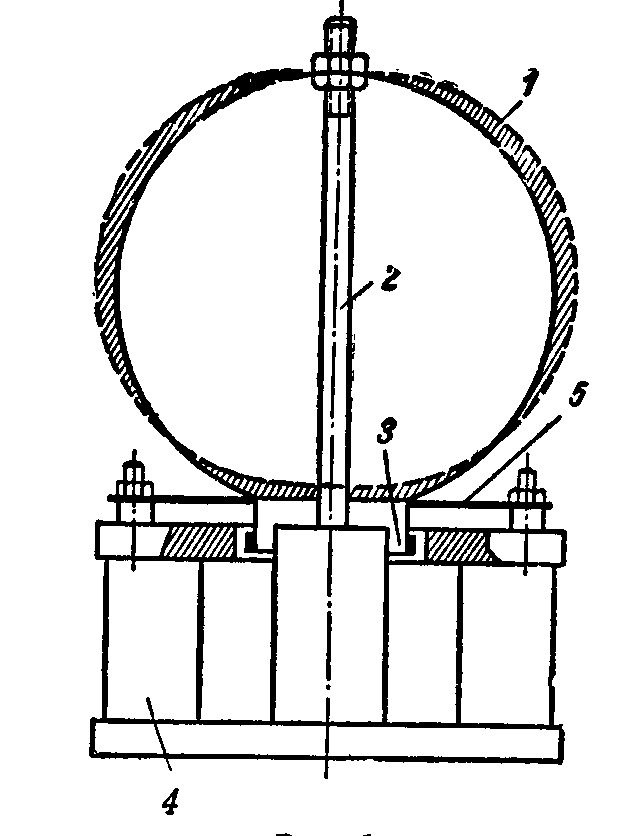While we are waiting for JC to come back -- has anyone ever seen the 'real' Z formula for a Cap with its parasitics? Or ESR of a 'real' capacitor?
[Exerpt from white paper I wrote a million years ago.] -RNM
As I usually ask put some numbers on these and show the real magnitude of the audio band abberations. I would expect the parallel resistance and lead inductance to make little or no contribution at all.
BTW I disagree with the caption on 2a the measured C depends on the frequency of measurement, as you approach DC you measure all the C. The comment about Qa not contributing to the potential, I don't get at all what that's supposed to mean.
I think those big shapes throb
The little ones too, Mr Wurcer.
Each consists of three pairs of pulsating boobs, I normally only see the big ones (i failed the Rorschach, evidently)
As I usually ask put some numbers on these and show the real magnitude of the audio band abberations. I would expect the parallel resistance and lead inductance to make little or no contribution at all.
BTW I disagree with the caption on 2a the measured C depends on the frequency of measurement, as you approach DC you measure all the C. The comment about Qa not contributing to the potential, I don't get at all what that's supposed to mean.
Numbers: it all depends on the application. Since this is only about cap parasitics, no app number were provided. In fact, it wasnt actually for audio only... caps in general plus some comparison info with my patented cap. You will have to put the numbers in for your own app. S/H, filter, HF, high current, high temp, etal. If you dont know the parasitics, it could make or break a design. For audio -- biggest issue is in speaker cross-overs which have to pass high currents. Particularly of interest would be the bipolar types often used there.
Yes, c can vary with freq.... depends on dielectric material. Varies with temp as well. Shown in cap mfr literature.
So even these more complete formulas are simplified somewhat.
Thx,
Richard
Last edited:
I heard the "single" version. Images were VERY realistically scaled and as you know, I'm an imaging freak. Still just about the only commercial speaker I've lusted after.
Long time ago, I heard the single version at a Stereophile show. They were playing a Mel Torme LP. It did image really well, and had a very you are there quality. I had never heard or seen the speaker before and didn't know to think cause it sound so different. I decided there was something wrong with that speaker!!
I really liked the Soundlab A1 speakers I heard at that show, but wish I had listened more to the MBL with some music I was familiar with ( that room was very busy).
John
phase of C's and L's -
Many people think that a broad low Z power supply is desireable - beyond ripple smoothing. The large value electrolytic caps have high inductance (unless special techniques are used $$). Bypassing with smaller value, lower Ls, film caps has been used for a long time to extend the bandwidth of the pwr supply filtering - beyond ripple filtering.
That can all be lost with just a few inches of added lead length -- wiring - whether pcb or wire from Pwr Supply to circuit. I still see circuits assembled with the ps bypass caps remote from the circuitry ... little benifit and waste of money. Shown is how just 12 inches of lead length added has nullified the effects and you are back to what would be the z of the single ripple filter cap. -RNM

Many people think that a broad low Z power supply is desireable - beyond ripple smoothing. The large value electrolytic caps have high inductance (unless special techniques are used $$). Bypassing with smaller value, lower Ls, film caps has been used for a long time to extend the bandwidth of the pwr supply filtering - beyond ripple filtering.
That can all be lost with just a few inches of added lead length -- wiring - whether pcb or wire from Pwr Supply to circuit. I still see circuits assembled with the ps bypass caps remote from the circuitry ... little benifit and waste of money. Shown is how just 12 inches of lead length added has nullified the effects and you are back to what would be the z of the single ripple filter cap. -RNM

Last edited:
Those speakers look interesting.
I have never listened to one of them, but as I understand it, they are very good.
The motor looks like a regular "moving coil" dynamic loudspeaker motor.
The tricky part is the” boobs© Jacco™” blades.
"Radialstrahler" technology - MBL
MBL 101 X-treme with Jurgen Reis.mp4 - YouTube
BTW: Brian thanks for the PM
Cheers
Stein
I have never listened to one of them, but as I understand it, they are very good.
The motor looks like a regular "moving coil" dynamic loudspeaker motor.
The tricky part is the” boobs© Jacco™” blades.
"Radialstrahler" technology - MBL
MBL 101 X-treme with Jurgen Reis.mp4 - YouTube
BTW: Brian thanks for the PM
Cheers
Stein
Long time ago, I heard the single version at a Stereophile show.
First MBL radial single is from the 1980's, i've audited all revisions from the 101(A) to the X-101, they've come a long way since.
Complements of Mr (not a BT) Uskokovic : MBL Radialstrahler - YouTube
(say it's not a t*tty bar)
Attachments
Last edited:
First MBL radial single is from the 1980's, i've audited all revisions from the 101(A) to the X-101, they've come a long way since.
Complements of Mr (not a BT) Uskokovic : MBL Radialstrahler - YouTube
(say it's not a t*tty bar)
BT means??
First MBL radial single is from the 1980's, i've audited all revisions from the 101(A) to the X-101, they've come a long way since.
Complements of Mr (not a BT) Uskokovic : MBL Radialstrahler - YouTube
(say it's not a t*tty bar)
Radio, #8 1957, page 57, reference on "Funkschau", #22, 1956
http://www.radioman-portal.ru/magazin/radio/1957/8.djvu
Here is the topic: http://www.diyaudio.com/forums/planars-exotics/190507-ball-shaped-tweeters-any-success.html
Last edited:
BT means??
What's the name of this thread ?
(the part between brackets was an insider jokey for 1st row seaters of this room who've been attending a bit longer)
Anatoliy,
the MBL gents in Berlin had already been studying the bulging booby concept for quite a lengthy period before they brought out the first radialstrahler, think over a decade, which makes it early '70s.
Last edited:
people in Germany experimented with such concept at least back in 1956.
Probably where they pinched the idea from , no ?
Early 70s minus 1956 isn't such a long stretch. (MBL 100 => 1979)
Many people think that a broad low Z power supply is desireable - beyond ripple smoothing.
Dick, this is the Blowtorch thread and I think the average level of sophistication here is above being reminded to not have 12" leads on high frequency bypass capacitors. Not to say this isn't all good stuff but I usually figure we are talking about low level coupling and RIAA use.
The GR650 capacitance bridge operation and use manual circa 1956 covers just about everything you need to know about capacitors (except possibly their "sound").
See, big melons, even they say so.
So what, if they are stationary?
I prefer arrays in the wall, around movie screen.
See, big melons, even they say so.
And the "balls" on the low end. The most beautiful LS today, definately in the eyes of the beholder or father. I'm sure they sound great.
Wavebourn, thanks for posting the round tweeter.
Interestingly, because of the distance between the drivers, the MBL x-treme will be more like an array with 360 degree dispersion than a true point source. Therefore, you might like them, although putting them in the wall around a screen might be difficult.
vac
Interestingly, because of the distance between the drivers, the MBL x-treme will be more like an array with 360 degree dispersion than a true point source. Therefore, you might like them, although putting them in the wall around a screen might be difficult.
vac
- Status
- Not open for further replies.
- Home
- Member Areas
- The Lounge
- John Curl's Blowtorch preamplifier part II

